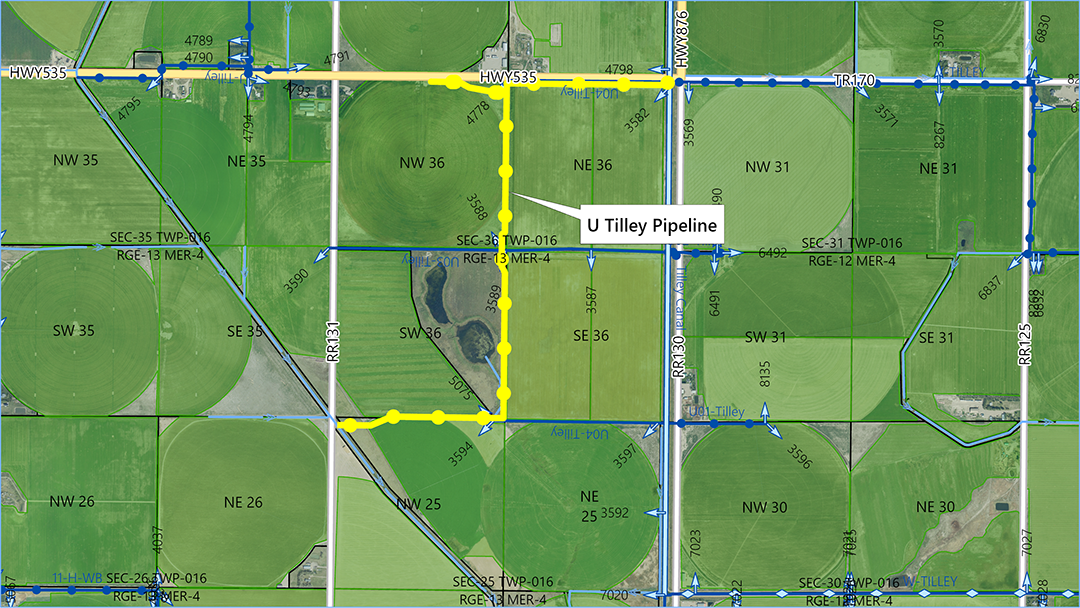In consultation with Operations, the following were identified in need of replacement or required for addition to current District works:
This year’s Structures Program will be funded under the Capital Works Program for an estimated total cost $765,000.

The S Tilley and T Tilley rehabilitation project is located 4 km south of Tilley. This project continues the conversion of ditches to pipelines which stem from the Tilley Canal. The rehab will consist of a closed gravity pipeline which will tie 2 canals into 1 pipeline system, supplying 1,164 acres. As this system experiences significant aquatic weeds, a gabion rock wall will be installed for filtration. The project will be funded under the AIM program at an estimated cost of $2,477,000.
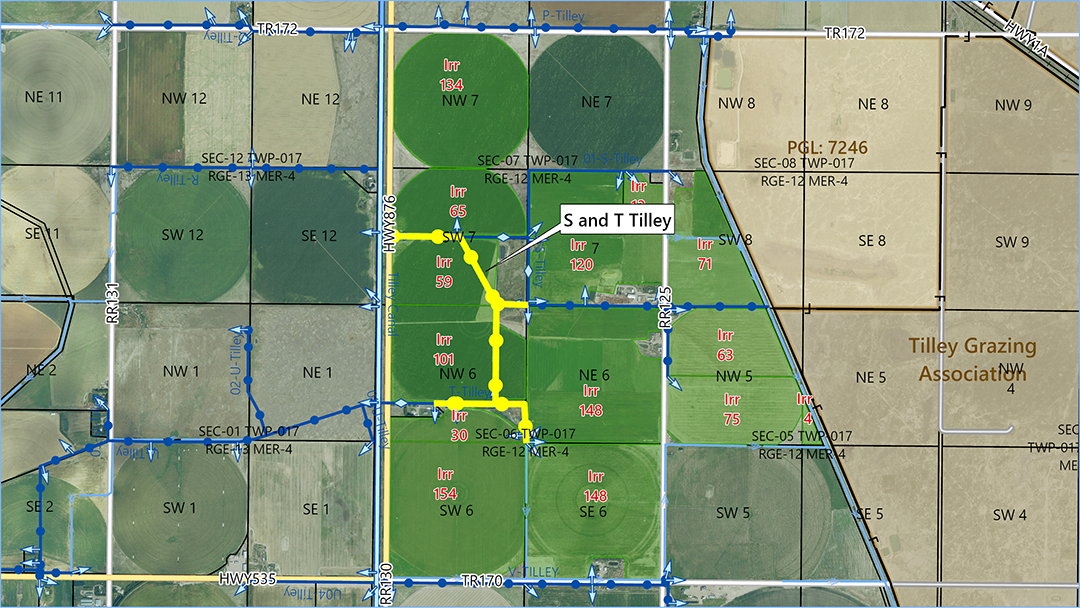
The X Tilley Pipeline rehabilitation project is located 9 km south of Tilley and is slated for the 2025/2026 construction year. The rehab consists of 1 closed gravity pipeline which will replace 2 separate canals. The pipeline will have a stilling pond and gabion wall installed; and will be upsized and extended to serve 5 additional parcels to the south. The system will supply 1,261 irrigation acres and will improve the ability to meet the needs of the downstream irrigators early in the season, if/when Bantry 1 and Bantry 2 reservoirs are low. This project is funded under the AIM program at an estimated cost of $4,338,000.
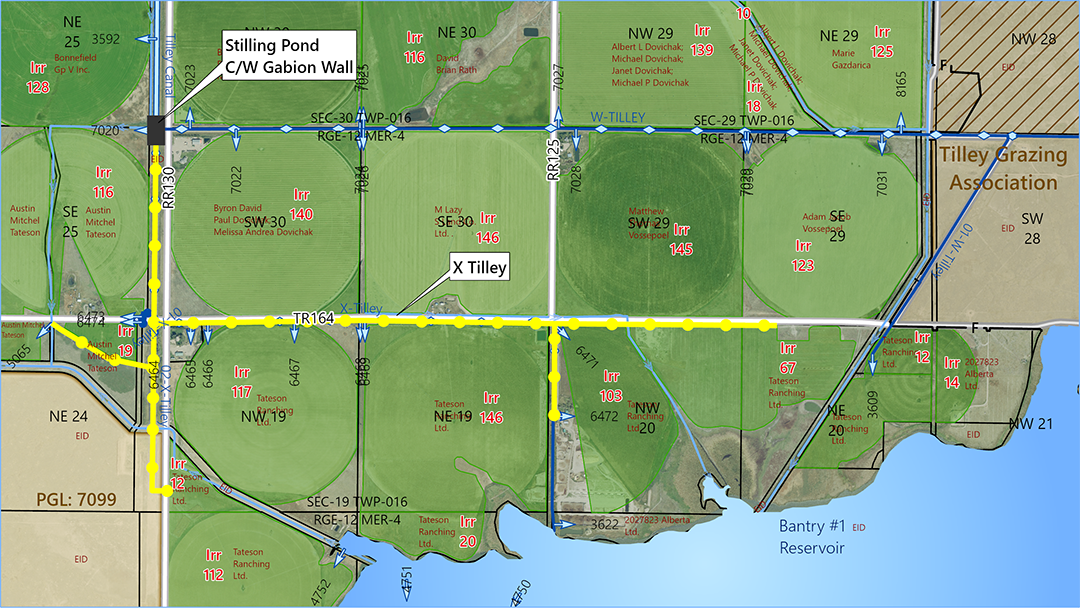
The Environmental Impact Assessment (EIA) for the Snake Lake Reservoir expansion project has been completed, 22 individual sections have been written to evaluate the existing conditions and to define the environmental impacts of building the reservoir. All sections have been reviewed and finalized by third party engineers, consultants, and the EID. Technical documents have also been developed to assist in the design of the reservoir and include detailed investigations of the ground conditions under the proposed dam, the ground conditions within the reservoir where the borrow material will be excavated, the impacts of major storm events on the expanded reservoir, the impacts of a dam breach on the downstream lands and infrastructure, a preliminary investigation into a new outlet structure with increased capacity, and investigations into riprap and filter sand supply and transport to site. The EIA was submitted to Alberta Environment and Protected Areas (AEPA) on April 2nd. Following submission to AEPA, the document will be reviewed for completeness and to ensure it meets the Final Terms of Reference. The Natural Resources Conservation Board (NRCB) will also review the submission. AEPA will also require approval under the Alberta Water Act prior to construction. It is expected that approvals will take a minimum of 1 year.
The Snake Lake Canal rehab project was approved at the June 24, 2025, EID Board Meeting. The 300 cfs canal starts at the east dam of the existing reservoir and runs east and north under the CPR tracks and Trans Canada Highway, delivering into the Springhill Canal. Part of the expansion plan for the Snake Lake Reservoir is to upgrade the Snake Lake Canal to 800 cfs to be able to supply the +50,000 downstream irrigation acres when the reservoir is completed. The rehabilitation consists of widening the canal on the 5 km stretch outside the expanded reservoir footprint, installing gravel armour, upgrading the concrete syphon at the tracks, and open-cutting across the highway to install a concrete pipe, all to handle the increased flow. This project will be funded under the IRP program for an estimated cost of $19,500,000; to begin construction in late summer or fall of 2025.
The EID and the Hutterian Brethren of Bow City executed a purchase agreement dated February 18, 2025, for the purchase by EID of approximately 372.60 acres of land located within SE 11, E ½ 02, E ½ 01-18-18 W4M and Pt of NW, NE & SE 36-17-18 W4M. Gravel deposits on the purchased lands will support the construction, operation, and maintenance of the Snake Lake Reservoir Expansion and/or other EID projects.
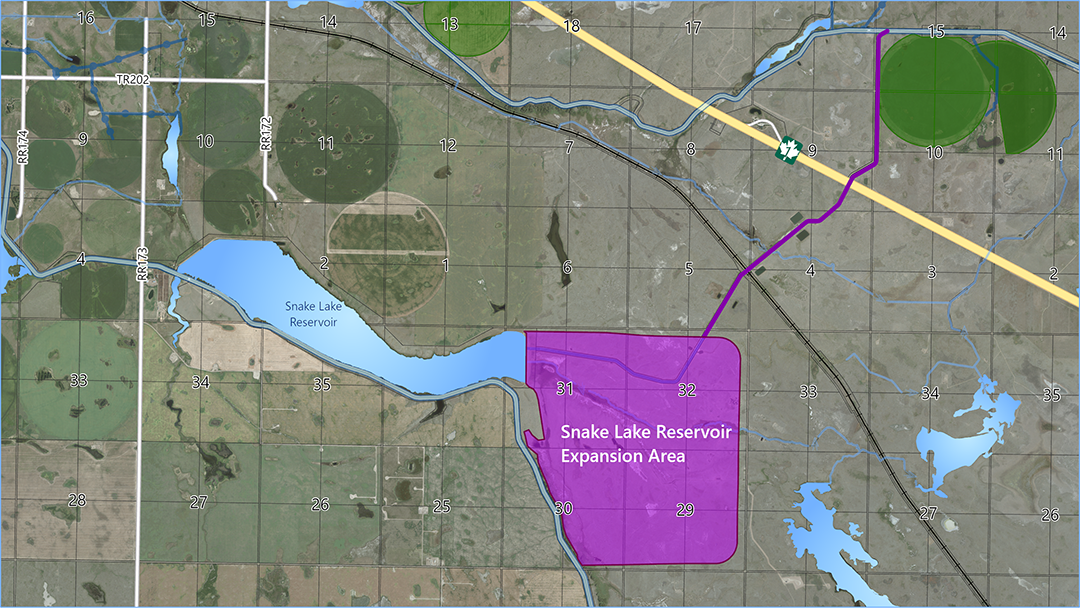
The 17-G Springhill Pipeline project begins approximately 10 km NW of Patricia, ending approximately 14.5 km directly north of Patricia where the canal ties into an existing pipeline; currently irrigating 3,780 acres, of which 450 are flood. Due to this project being in the 5-year plan, maintenance has been deferred and many of the structures and crossings are due for replacement. The canal has significant silt and weed growth and is treated regularly for algae. The new pipeline will be 7.7 km long, tie into 2 existing pipelines, and be sized for an additional 900 acres of irrigation. The project will save water by eliminating seepage and evaporation and would also reduce spill. The project is slated for the 2025/2026 construction year at an estimated cost of $11,960,000; to be funded under the AIM program.
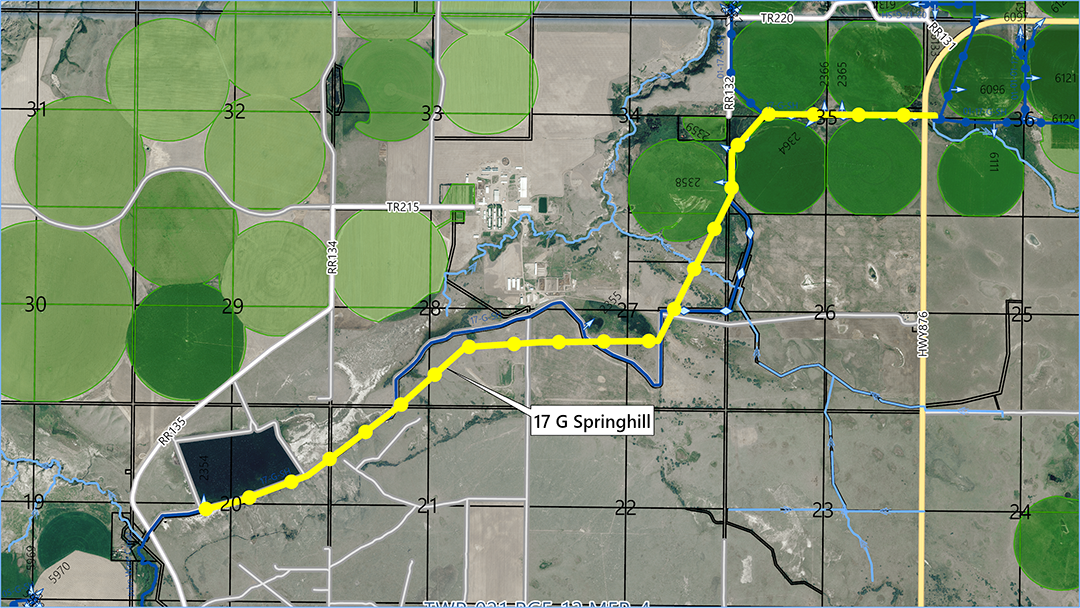
2 isolation valves will be installed in the Secondary C North Branch Pipeline. The purpose of the isolation valves is to mitigate future interruption of water conveyance in the large-scale system, when repair work or maintenance of the pipeline may be required. This system currently serves over 7,000 irrigation acres. A knife gate valve in a CSP well will be installed in 2 locations – SE 14-22-17 W4M and SW 12-22-17 W4M, for a total project cost of $255,000; to be funded under the Capital Works program.
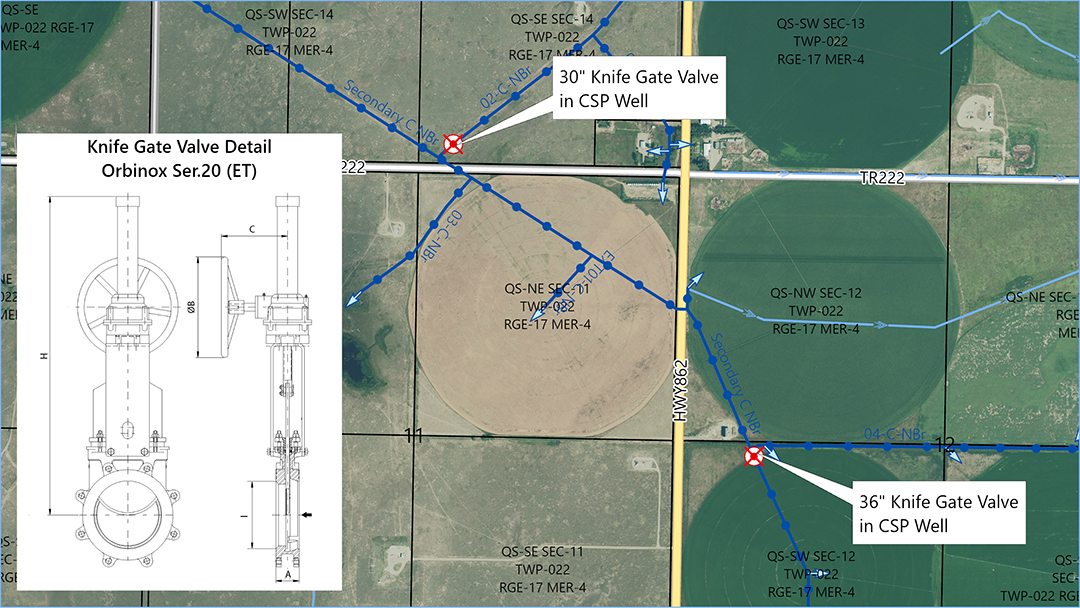
The 300 cfs Snake Lake Canal starts at the east dam of the existing reservoir and runs east and north under the CPR tracks and Trans Canada Highway, delivering into the Springhill Canal. Part of the expansion plan for the Snake Lake Reservoir is to upgrade the Snake Lake Canal to 800 cfs to be able to supply the +50,000 downstream irrigation acres when the reservoir is completed. The rehabilitation consists of widening the canal on the 5 km stretch outside the expanded reservoir footprint, installing gravel armour, upgrading the concrete syphon at the tracks, and open-cutting across the highway to install a concrete pipe, all to handle the increased flow. This project will be funded under the IRP program for an estimated cost of $19,500,000; to begin construction in late summer or fall of 2025.

The Main Bantry Canal supplies water from Lake Newell Reservoir to Rolling Hills, Tilley, One Tree, and Patricia areas. The earthen Brooks Aqueduct, which replaced the concrete aqueduct in 1978, allows the EID to get water across a low area to these regions. The earthen aqueduct is 4 km long, includes a syphon under a railway, and has a capacity of 950 cfs. Although the canal was designed with a maximum height of 16 m it has settled up to 50 cm over the past near-50 years. While it is currently possible to convey 950 cfs there would only be 40 cm of freeboard instead of the designed 90 cm. The rehab project will increase the height of the banks with clay material and add armour at an estimated cost of $708,000 to be funded under the Capital Works program.
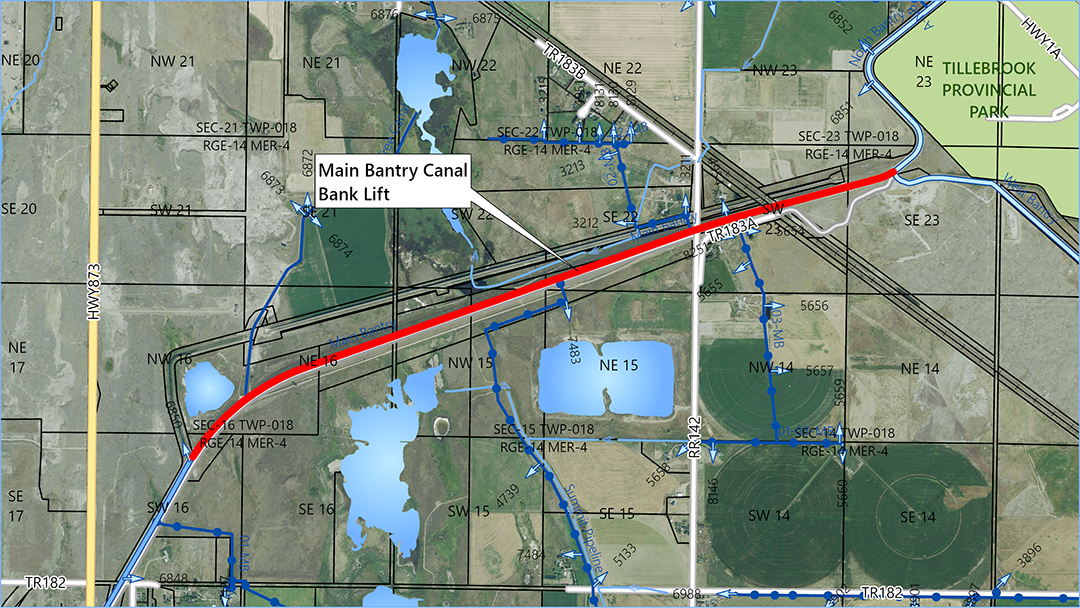
The U Tilley Pipeline (03-U, 04-U North and 04-U South Canals) rehabilitation project begins 5.5 km south of Tilley at the intersection of Hwy #876 and #535. The total area served is 240 irrigation acres, of which 87 are currently flood. Information provided was the road borrow being used as a head ditch, the canal condition restricting flow, and canals overflowing when checked up to adequate levels. The proposed rehab consists of a single 4 km long closed gravity pipeline sized for pivots to receive 3.0 cfs. It is funded under the AIM program at an estimated cost of $1,180,000.
